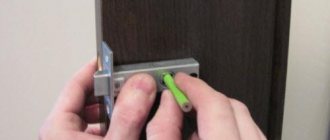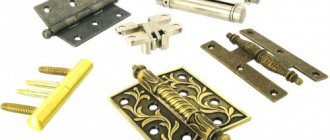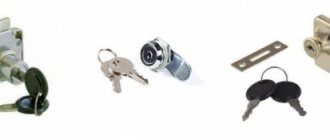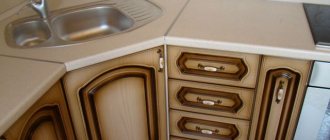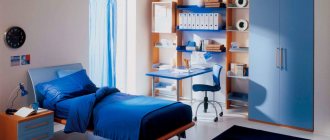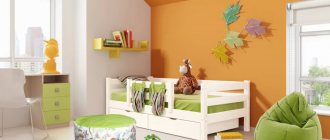Locks, Accessories
As soon as a small child begins to move independently around the bed, playpen, and then around the room, parents take their heads: his path is filled with many dangerous objects and places. These include sharp corners of furniture and crossbars, sockets and nails, cabinet drawers and doors. This is where the primary task of parents is to ensure the safety of the little one. To prevent the child from pinching his fingers, leaving the room on his own, or the door not closing, special door locks are used.
Lock against accidental closure
Locking devices for drawers
First of all, let's turn our attention to the simplest options for locking drawer cabinets using special latches.
The price of the issue is one and a half to two hundred rubles and five minutes of time spent on installing the latches. Such locking devices are very common, they can be purchased in almost any store that sells children's goods. There are many names for such devices, for example canpol babies or drawer safety lock.
Such latches are made of plastic and glued to furniture using special reliable Velcro. Over time, they can be carefully torn off, without leaving any traces of glue. The latch consists of two elements, the main device and a plastic counterpart. The device is attached to the edge of the drawer with an overlap on its edge, and the counter part is glued to the body of the piece of furniture. When closing the drawer, you snap it tightly; to open it, you need to simultaneously press two small ears that are located on the body of the device.
A slightly more expensive and complicated, but even more effective way to lock a drawer is to use a handle with a built-in lock. The complexity of this method lies in the need to select a suitable handle so that it fits in place of the piece of furniture you are dismantling. Having bought a new handle, you simply screw it in place of the old one and lock the drawer.
How to lock a wardrobe from children?
Sliding wardrobes with mirrors are very attractive objects for small children. They are drawn to kiss the mirror, roll doors back and forth and pull out things standing on the lower shelves. Under these conditions, you will think about the need for child protection on the wardrobe. After all, pinched fingers and broken doors are the most innocent troubles that can arise as a result of a child’s acquaintance with such furniture.
You cannot install a classic lock on the door leaf of a sliding wardrobe, since it has a completely different opening principle. But this does not mean at all that there are no ways to reliably protect the closet from the attacks of a naughty child. There are two reliable ways to lock a wardrobe: the first method involves using a multi-purpose latch, and the second is using a special lock designed for such furniture.
The multi-purpose latch consists of three plastic parts connected by a special cable. One plastic part is firmly attached with glue to the door leaf of the wardrobe, and the other, called the retainer, hangs freely on a cable. If there is a need to lock the door, you just need to insert the lock into the counterpart attached to the cabinet body, and the opening is carried out with a special secret button.
A specialized fastener for sliding wardrobes has even greater advantages, since it does not need to be glued to the door leaf. It is attached with a latch directly to the handle. To lock the door, you just need to close it all the way, and the latch will come into contact with the cabinet body and block the door leaf. Opening is carried out by pressing a secret button “on the body” of the latch.
To summarize, we note that child protection on drawers and cabinets is not a manifestation of suspiciousness, but a severe necessity. After all, any closet or drawer can easily injure a child. Not to mention the dangerous things that such furniture can hide. Therefore, take care of your children in advance, especially since thanks to modern technology this requires minimal effort.
Interesting:
- Child locks for furniture
- Child lock on refrigerator
- Locks for metal and iron cabinets
- How to open a mailbox lock
- Window locks - all the subtleties of selection and installation
- Child locks on windows
Door plugs
For a small child, the entire apartment is one continuous threat. And even such a seemingly harmless thing as a door carries a danger for him: a baby can, while holding onto the door, accidentally close it and get his fingers pinched.
Protection for interior doors also comes in different configurations, but the essence is the same - to prevent the door from closing. This can be a small prop that fits under the door, or a large, U-shaped rubber pad that fits anywhere on the door to prevent it from closing.
So, buying childproof furniture today is not a whim, but a necessity caused by the activity and curiosity of a rapidly developing baby. Remember: a pinched finger is the most harmless thing that can happen if you don’t take care of your baby’s safety.
Inspire us - share the material with your friends on social networks:
Read with this article:
Additional security elements
To make a child's room and the entire apartment or house safer for a small child, you can use not only furniture mortise locks or the considered locks, but also a number of additional auxiliary components. For some, they can become the main decisions in the field of preserving the health of the baby.
- Shock absorbers. Plastic or rubber products that are attached to retractable furniture, doors, sharp corners and edges;
- Plugs. They serve to block access to screws, nails, and some decorative elements that are dangerous for children;
- Covers for edges and corners. Most often they are made on the basis of soft silicone;
- Protective tapes. They are used to cover the edges of various furniture. They are made on the basis of rubber or silicone with a sticky base for strong fixation.
I advise you to go to specialized stores and choose the best protection options.
The need to protect furniture
A small child finds everything that happens around him interesting, so situations often arise that threaten the baby’s health. The time when children begin to crawl and walk is considered especially dangerous, since the danger will be from sharp corners and doors of furniture, sockets, and household appliances. Young children especially actively begin to explore the world from the contents of the closet and shelves. Some things can be removed or moved higher, but the sharp corners of tables, sofas, chairs, and drawers remain.
To reduce the risk of injury to a child, caring parents resort to tricks - installing protection, limiters and blockers. Sometimes such devices are made independently, but a more reliable option is special products that can be purchased at hardware stores.
Manufacturing process
Stage 1
We drill a through hole 7 mm as in the photo. And in the box itself there is a hole of 3-4 mm and a depth of about 10 mm.
Stage 2
We prepare the screw: grind the thread and shorten it.
Stage 3
Insert the plastic plug into the screw head.
The homemade product can be modified: screw a 10x30mm metal plate onto the bottom drawers. Then, to open any bottom drawer, you will have to pull out the top one. A little inconvenient, but all the drawers are locked.
Outwardly, nothing is noticeable - the plug does not stand out against the general background. And if you don’t know the secret, you won’t guess it right away. Such a “lock” can be made not only on drawers, but also on doors!
Category: DIY furniture
0 Complaint Similar homemade products
We repair a furniture box ourselves. Woodland-style cribs. Homemade products for assembling furniture and baguettes.
Shelves made of wooden boxes
Chairs made from bottle crates
How to make a wardrobe out of drawers 3 comments×
Safety in the nursery and other rooms
A completely safe home for a child will only be possible if you think through everything in detail and pay attention to every corner of your home. Let's start with the nursery
This is where the child spends most of his time, often without adult supervision. First of all, you need to look at what is around the crib and move it to the side if there is an electrical outlet nearby, a table or shelf with medicines and baby care products, pots with indoor flowers, a closet with opening doors.
The loft bed or bunk bed must also be safe, that is, have appropriate barriers to prevent the child from falling. The Swedish wall is unthinkable without a soft mat.
When a child begins to crawl, some parents solve the issue of child safety in the apartment by purchasing a playpen. If restricting your baby’s freedom of movement is not your method, then take a careful look around. What can attract a child, what can he reach? Lock all cabinets with doors, remove all hanging objects from tables and shelves, this can be not only tablecloths, but also hanging wires of landline phones, table lamps, irons and other heavy objects.
Be sure to cover all sockets with plugs - this is the most basic safety aspect for children regarding electricity. In addition, there are special cases for sale for surge protectors and protective boxes for sockets.
All cabinets, shelves and shelves must be securely fastened so that a climbing baby cannot tip them over. And, of course, all the corners in the children's room should not be sharp and dangerous - for this there are silicone pads that are glued to the corners of tables, bedside tables, cabinets, chests of drawers and protect the child from injury.
Separately, we need to talk about interior doors and cabinet doors. To prevent a child from accidentally pinching their hand, it is better to install child protection on the doors, for example, a door shock absorber, which prevents the door from slamming suddenly. Lockers will not allow a child to open the cabinet doors, and special child safety barriers and flexible locks will protect against children from entering the depths of the cabinets. A little advice - choose a lock that has a complex opening system, for example, you need to press several buttons at the same time to unlock it.
And be sure to keep your front doors locked! By simply pressing the handle of the front door, the child will go to explore the staircase, and there, as you know, lurks the danger of falling from a height.
Child locks on drawers and cabinets: protecting children from danger
Your baby was recently born and now he is actively inspecting every corner of the apartment.
The lock prevents hanging drawers from opening completely.
here it becomes necessary to think about the safety of the little explorer from unwanted objects and sharp edges, doors and boxes, to which the young know-it-all is attracted like a magnet.
Using a drawer and door protector can prevent unwanted opening by a child.
Fortunately, the modern market is full of all kinds of devices that can completely protect a child from possible injuries and dangers that await him at home.
To protect the contents of drawers from children, you must use a drawer lock.
These items will give parents more peace of mind and will also help them get rid of the extra work associated with putting things in lockers that were damaged by a child.
Prevents drawers and refrigerators from opening.
As soon as the baby begins to stand up or actively crawl around the house, parents need to think about the possible dangers that lurk within the walls of the apartment.
Prevents drawers from opening and bruising your child.
Cabinets and drawers with potentially dangerous objects attract a small child, and the doors themselves can injure him by pressing on his fingers.
Prevents drawers from opening and bruising your child.
To prevent children from opening cabinets, there are child locks for furniture that are resistant to children's hands.
Prevents unplanned opening of cabinets and appliances.
Such locks are inexpensive, so purchasing them turns out to be very advisable.
The lock prevents hanging drawers from opening completely.
The type of lock directly depends on the nature of the cabinet being locked and the method of opening it. After all, to protect a drawer from a thief, you need a completely different device than a sliding wardrobe with doors.
The universal Velcro seat belt protects your child from opening the refrigerator, toilet seat, desk drawers, etc.
Danger of electric current for a child
To date, there are no children who are safe from electric shock.
If parents do not take precautions, then your child may also be in danger. If a child tries to insert a fork or other metal objects into the device, then you will not be able to avoid the danger.
This is why many parents prefer special sockets. They are created in such a way that it will be difficult for a child to notice them.
Also today there are a number of devices that have protective properties. Special sockets can prevent tragedy, but not always. You should never rely on technology, as sometimes it can work too late. In this case, you will not be able to save the child’s life. If we talk about sockets that have a protective device, then you should remember that their installation is appropriate in the bathroom.
Instructions for locking cabinets and cabinets from children:
- If the furniture is equipped with locks, then it is necessary to close all doors with keys, and then put them out of the reach of children.
- Hinged cabinet doors can be closed by tying adjacent handles together with rope. To do this, the rope is passed between the handles in the shape of a figure eight and tied in a knot. This method is suitable for shelves that are used on rare occasions.
- For doors and drawers that have to be used frequently, special protective devices purchased in children's and hardware stores are suitable. A locking lock is an easy-to-use and inexpensive mechanism that is designed for different types of doors. Using these locks, you can easily lock sliding, folding and swing doors with close adjacent handles. They are produced in various versions. For example, to lock swing doors, use U- and C-shaped locks and locking rings for cabinet handles. After dismantling, they do not leave any marks on the surface of the furniture.
- It is convenient to glue soft locks to sliding and glass surfaces without handles. Thanks to the adhesive surface of the clamps, they are easy to dismantle, because they do not leave marks on the furniture. The disadvantage of soft locks is that a child can learn to open them on their own, but this can be overcome by gluing the locks higher. In addition, these universal locks are used on the surface of the refrigerator, microwave oven, toilet lid and even on windows.
- The latches will help prevent the drawer from falling out on your feet. They are attached from the inside with screws or Velcro on the side from the outside. The side latch can only be opened by pressing the buttons simultaneously while pulling the drawer towards you.
There are many manufacturers of home security devices. The most popular are the following:
- Mothercare (UK);
- World of Childhood (Russia);
- Canpol (Poland);
- Chicco, Poupy, Brevi (Italy);
- Safety First (Netherlands);
- Baby Dan (Denmark);
- Bebe Confort (France);
- IKEA (Sweden).
Products of Polish and Russian brands have an affordable price, which can be 5-7 times lower than that of brands from European manufacturers, while the quality of their products is also at the same high level.
Even if you consider all these protective devices to be a whim of inventors, you will still have to come up with something at the moment when the baby learns to crawl. After all, literally everything falls into his field of vision - from a boiling kettle on the stove to a mosquito net on the windows. So, various protections are not a whim, but a necessity for those conscious parents who do not want to remember the first couple of years of the baby’s life as time spent in traumatology.
The danger of basic household items cannot be underestimated - burns, falls, bruises and fractures are possible, because the child does not know how to properly handle the familiar objects around us.
Safety for children at home: door lock
Types of children's blockers
For windows
They do not allow the frame to be opened or inform the parent with a loud sound that the window has opened. You should choose them taking into account the type of window: rising, sliding, opening inward or outward.
Flexible devices
There is also a universal type of device; they cover windows, any cabinets and a refrigerator. They are made of flexible material and are attached using an adhesive base at a height that a tomboy definitely cannot reach.
For drawers
The lock will prevent the drawer from being pulled out, protecting children from the drawer falling on their feet when opened abruptly. Such devices are secured with small screws from the inside.
Using such locks live:
But such protection does not always work - the test drive from the girl Yana failed...
Corner clamps
They are used for various cabinets, they are attached to the side and do not allow the door to be opened, they are often made of plastic, but are reliable.
For toilet lid
Children love to wash their hands in the toilet and throw toys in it, but they will not be able to open the lid, which is secured with a toilet lid lock.
For doors
There are two types: some fix the door in a certain position, while others do not allow it to be closed completely. The second type is in great demand, as soft shock absorbers allow you to use the door as safely as possible.
Plugs for sockets
Thanks to this plug, the baby will not be able to put anything into the socket.
They can be made of plastic or rubber.
Review of protective devices from a wise dad:
Defense Mechanisms
The simplest devices for locking cabinet doors and cabinets can be made with your own hands. Our mothers and grandmothers used such simple methods using improvised means. Two adjacent door handles can be tied with a strong thick thread, rope or elastic band.
The disadvantage of this method is that the baby may well, over time, master the method of getting rid of such a “lock” and, with his own hands, open up access to the hidden depths of the furniture shelves. In addition, this is inconvenient for adults themselves, because the rope or elastic band will have to be removed every time you need to take something from the closet, and then re-attached to the handle.
Drawers or wardrobe doors can be blocked by gluing a strip of wide adhesive tape or insulating tape to their sliding surface. The disadvantages of this method are the same as those described above. In addition, the tape will leave sticky marks that are difficult to remove on furniture surfaces. You can curtain a chest of drawers or a cabinet with a large blanket or tablecloth.
The child will most likely see only a solid piece of matter and move on to more interesting things. This method is only suitable for very small and unintelligent children. It can be used as a temporary measure until more secure locking devices can be installed as soon as possible.
Sometimes furniture doors or drawers are equipped with mortise locks. Basically, such locks were often found in old furniture. In this case, you just need to find the key and do not forget to close the lock on the furniture with it after each use. Keep keys to cabinets and shelves out of the reach of small children. And of course, it is very undesirable to forget the storage location or lose the treasured key. In this case, taking the necessary items from bedside tables and chests of drawers will no longer be possible for an adult. However, modern furniture manufacturers do not often embed locks into drawers and doors.
If possible, it is better to take care of such furniture in advance by choosing the appropriate model or having it made to special order. It is not entirely advisable to embed such locks into existing furniture. The difficulty is choosing the lock itself.
Are they really necessary?
Many parents have become convinced of the convenience and safety of using locking devices for furniture doors and drawers. When there is a little explorer in the house, you should not skimp on safety measures. Moreover, manufacturers provide a very wide range of locks and locks for cabinet doors and drawers.
In addition to the fact that such devices and mechanisms protect the baby from injuries and dangers associated with heavy or sharp objects, chemicals from cabinet shelves, they also relieve parents from forced cleaning. While exploring the spaces of a chest of drawers or drawers, the baby often leaves behind a decent mess.
Parents of especially active and inquisitive little ones have to put things in order and do cleaning several times a day. Before mom has time to sort out the clothes thrown out of the drawer, the sound of tubes of cream and bottles of eau de toilette falling to the floor, or even the sound of a broken cup, can already be heard from the next room.
Scolding a child for his natural interest in his surroundings is almost the same as scolding a person for wanting to sleep or eat. The development of intelligence and physical functions is inextricably linked with the practical study of the world. The baby actively moves, looks at, touches objects, and drags them into his mouth. He does this not at all out of conscious mischief, and not out of a desire to deliberately annoy you. Remember this. Do not limit the child in his natural development by making scandals and scolding him for sloppiness.
Although it’s a rare mother who manages to contain her anger and irritation after yet another misstep by the fidget. The baby does not have the skills to carefully handle objects, but he will learn just this and much more throughout the first months and years of his life. You can make this process mutually enjoyable, interesting and safe enough for your child only with the protective help of parents.
For an overview of child safety locks on drawers in action, see below.
Interlock locks
As for the furniture itself, its design should not raise doubts about its stability; there should be no sharp corners. Shaky furniture should be strengthened or moved to another room where the baby has no access. The task of parents is to protect their child from possible bruises, and themselves from unwanted disorder.
All parents know how dangerous it is to play with the closet door. To prevent your child from accidentally pinching his fingers or using prohibited items for play, you can use special devices. These are so-called blocking locks.
They differ depending on the types of doors:
For door wardrobes and sliding wardrobes. Universal models are designed for two types of doors. The device looks like two button-shaped clips that are glued to the cabinet: there are models with an adhesive base or with suction cups. They are connected to each other with an elastic plastic tape.
For swing doors. This option differs in the need to use screws. Such products are suitable for wooden furniture. One part of the blocker is screwed from the inside to the door, the other to the top wall. Swing doors are also locked using U- and C-shaped locks and rings that fit onto the cabinet handles.
For glass. Some cabinets have fragile transparent doors, and they arouse special interest from children: after all, through glass everything seems even more tempting. Locks in the form of hook-locks are specially made for glass doors.
Types and models of blockers
Locking locks are designed for hinged sashes and doors. Depending on the type of handles on the doors, they come in different shapes. These locks are very easy and quick to install on cabinet handles and securely hold the doors in the closed position. Door locks of this type look neat and will not damage your furniture. They do not tear or stretch when opened and closed multiple times, and are quite strong and durable.
For sliding doors and drawers in a chest of drawers or cabinets, soft Velcro locks are suitable. They are attached to the side and front surfaces of the furniture and connected with a special fastener, thereby keeping the drawer from sliding out. Depending on the model, the locking mechanisms may be different: special hidden buttons, hooks and ears. Locks of this type can also be used to lock the doors of kitchen appliances that are dangerous for children (refrigerator, microwave oven, oven). After all, the baby is unlikely to limit his travels to the living room and his children's room.
To protect the child from a heavy box falling on his feet, you can attach special latches that block the extension. Even if a young fidget somehow manages the lock blocking the drawer, the latch will work when pulled out and will not allow the drawer to be pulled out of the cabinet too far. Such devices are attached to the inside of the furniture and block the movement of the drawer to a certain amplitude. Fastening is carried out either using bolts or using holders glued to the inner surface of the box
More expensive models of locks and security devices are often equipped with a special built-in sensor that emits an audible signal when an attempt is made to open incorrectly (pulling the handle while the lock is closed or applying force to the mechanism itself). The intensity and type of sound signal can be adjusted through the settings. For vigilant parents, this is undoubtedly a significant advantage.
(no votes yet)
Locking devices for drawers
The most popular method of protection is special latches, one part of which is attached to the furniture frame using special Velcro, and the second half is attached to the front of the drawer. Such protective devices can be purchased in specialized children's stores. They are inexpensive, and not much time is spent on their installation. When the need for such latches passes, they can be easily removed, and not a trace will remain of them on the furniture.
There are many varieties of such latches, but their essence is that each such lock has a main element, which is fixed and remains motionless, and a counter part, which acts as a lock.
It is possible to install handles on furniture or, for example, on windows with a special built-in lock. But this method is a little more complicated than described above, since you will need to find handles that would fit in place of the handles installed on the furniture. After you have bought such a handle, it is installed on the drawer, and it is simply locked.
Homemade security features
You can make devices that prevent doors and cabinets from opening with your own hands; for this you need to use your imagination.
Parents seal cabinets with duct tape or put rubber bands on handles, and hide the extension cord in a cardboard box. If you make furniture protective devices yourself, make sure they are reliable before use.
Option for homemade protection from corners of furniture using polyurethane pipe and tape:
Homemade protection option for drawers:
Closing the closet from the child
Hinged cabinet doors are also better protected from children. Otherwise, leaving him alone for a minute, you risk returning to the room to find a pile of linen from the lower shelves and your little one happily frolicking with him. As a rule, U-shaped latches are installed on swing doors.
This is the simplest method of protection, since it does not require drilling holes in the furniture, or even gluing the protection to the surface of the furniture.
You can also use latches in the form of plastic hooks. They consist of two parts: the first part is attached to one cabinet door, and the other - the hook itself - is installed on the other door. When the doors are closed, the cabinet is locked with a hook.
The closet door can also be locked. A mirror on a wardrobe is a very attractive item for a baby. Usually, small children enthusiastically roll closet doors, look at their reflection in the mirror, and drag all the things from the lower shelves to the floor.
Of course, devices that are installed on hinged cabinets are not suitable for sliding wardrobes. But still, today there is protection for such furniture. The most popular type of security for sliding wardrobes is the butterfly latch. It is installed on one of the doors, next to the second door. When the “wings” are lowered, the cabinet door is in a movable state. By pressing a special button, the “butterfly wings” rise and prevent the cabinet door from rolling.
Correct installation of a child lock
Installation of the device does not require much time, effort or special training. An adult, knowing the instructions, can install the product independently. The installation technology is as follows:
- The first step is to disinfect the surface where it will be installed.
- If the blocker is based on glue and purchased when it is cold outside, then it should be given time to warm up at room temperature. When cold Velcro is applied, it does not attach well, sticks, and the stopper will not work well.
- To speed up the process, you can warm up the attachment point with a hairdryer.
- Next, remove the protective paper from the patch.
- The blocker is attached tightly closed to the desired location.
- When the design of the lock requires fastening with screws, you need to use a screwdriver to screw them into the places where the lock is installed. The mechanism can be opened and unlocked by simultaneously pressing buttons on both sides.
- To ensure the safety of children, wardrobes are often equipped with a top mortise latch.
- Sliding locks of the C- and I-shaped design are attached to swing doors, where the handles on the doors are located nearby - at a distance of 2.5-21.5 cm. To open it, you need to unfasten the latch on one side of the lock.
The locking lock has become popular in many countries. For young child researchers, the blocker has become an insurmountable obstacle, and for parents it is a guarantee of peace of mind and confidence that the child is safe.
Safety of children in the home:
Voted over 294 times, average rating 4.4
Comments
Unfortunately, there are no comments or reviews yet, but you can leave your...
Add a comment Cancel reply
We recommend reading
Locks, Accessories Characteristics of overhead door handles not associated with the lock mechanism The choice of door handles is wide. Models are divided by type of work into...
Locks, Accessories A simple scheme for creating a combination lock for entrance doors with your own hands. The entrance door is installed so that strangers and unwanted ...
Locks, Fittings Description, purpose and installation of the strike plate for a door lock Regardless of the cost and quality of the door, maintain good condition...
Locks, Accessories We reveal the intricacies of opening a combination lock. Sometimes when entering a combination of numbers, the combination lock can...
Protection for wardrobes
Typically, the sliding door of sliding wardrobes is equipped with a large mirror from the floor, which attracts small children. They want to touch it, the door, and when it opens, examine its contents.
It will limit access and reliably protect your fidget from possible injuries and bruises.
At the same time, things are constantly scattered from the lower shelves, and it becomes impossible to place equipment or potentially dangerous things. And the door threatens the little researcher with his finger pinched.
The lock is made of harmless material and does not contain phthalates.
For a rolling door, you cannot use a lock installed on classic doors, but you can use a multi-purpose latch or purchase a special lock for this type of furniture.
Prevents unplanned opening.
Multi-purpose latches consist of three parts connected by a special cable. One element is glued to the cabinet door. To close the device, you need to insert the protection into the part located on the body.
Locks and prevents unwanted opening by a child.
The device opens using a hidden button. It does not need to be glued to the walls, since this clamp is installed on the handle. Locking occurs automatically when the door is completely closed.
Suitable for cabinets, refrigerators, washing machines, microwave ovens.
It is clear to every parent that child locks on furniture are not excessive suspiciousness, but ways to protect their baby from real danger.
The protection blocks cabinet doors from opening.
Their use will not only help protect the child from possible injuries, but will also free parents to constantly clean up things scattered around the room from the lockers. Moreover, taking care of the safety of children today is not at all difficult and does not require a lot of money or effort for installation.
A magnetic lock that is installed on the outer surface of your furniture and the child will no longer be able to open those drawers and doors.
Mounted, not requiring additional installation
The easiest to install and most effective bollards are hinged ones. They are threaded through the door handles and secured with a stopper. No additional installation is required on the furniture frame.
There are models in flexible and rigid versions:
A mechanism with a polypropylene tape passed through a stopper (like those found in jackets for adjusting the tension of the elastic band).
This locking system can connect handles located at a distance of up to 20 cm from each other. In addition, the possibility of mechanical damage to the facades if the child persistently wants to open the door is practically eliminated (which cannot be said about the plastic bracket). Plastic bracket with lock . The design is rigid, which means that only closely spaced handles can be connected. The price is reasonable.
Padlocks cannot be used on all types of door fittings, but only on classic handle-brackets.
One of the disadvantages of hinged security devices is the likelihood of quick failure of door handles: loosening, breaking holes for self-tapping screws, breakage of fittings. Otherwise, the locks have proven themselves to be very reliable assistants.
Furniture protection devices
Not only cabinets, toilets and sockets, but also sharp furniture corners pose a danger to a child.
Corner covers
They are made of plastic, rubber or silicone. They can be bought at a children's store, usually as part of a set.
When purchasing, look carefully at the reviews - often such pads are not soft. And even if they protect you from hitting a corner, they will not soften the blow itself.
Soft tape, which is glued along the perimeter of sharp edges of furniture, protects the child from blows.
They have a self-adhesive base and cover sharp furniture elements, screws, nails, and decorative parts.
Safety devices against door slamming
They are attached to the door handle and prevent it from slamming. There is also an option to fix the pillow on the floor between the door and the wall, but it will interfere with walking. A child may trip over such a pillow.
You should definitely install protective plastic caps that will prevent the stove from turning on.
Adheses to glass and windows, will protect the child from injury if he accidentally breaks it
An inclined screen is installed on the end of the kitchen stove, preventing children from touching hot pots.
A plastic container with holes for wires where an extension cord is placed.
Baby safety gate
There are even special gates that prevent children from accessing undesirable places. They fence off part of the room, close the entrance to a separate room and prevent access to the stairs.
Types of child locks for furniture
There is a wide range of blockers on the market. They differ in:
- fastening mechanism;
- features of use;
- functionality.
There are blockers that are attached using special Velcro, that is, they can be removed if necessary. There are also stationary lock options.
In order to understand how you can close a closet from small children, you need to familiarize yourself with the options for locks and locks. The following models are distinguished:
- Locking locks with a fastening mechanism for the outer sides of the handles - such a mechanism securely connects the two doors of the cabinet and helps protect all the contents in it from damage and falling into the hands of those for whom it is not intended. The tightness of the blocking element will prevent children's fingers from getting caught between the two doors, thereby avoiding possible injuries. The mechanism consists of two components: a plastic cord with notches and a special attachment. The laces are wrapped around the handles, after which the attachment is used, which fixes the position of the lace. If an adult needs to take something, he can easily open the lock, but a child cannot do this.
- Universal blockers - the essence of the work is that the mechanism reliably connects the furniture door with its body. The strap is made of silicone, which is attached with one side to the door and the other to the base. This model is quite functional, because it can be used even on those pieces of furniture that do not have handles.
- Blocking shock absorbers - for the manufacture of such a device, materials with high elasticity and strength are used. It can be: silicone, foam rubber, rubber and others. The mechanism of this design differs from the previous ones in that it does not block the door, but simply prevents it from closing completely. This way, a small child will not nail his fingers, even with a strong clap, because the obstacle will leave a gap of a certain thickness. Fastening of this design occurs in the upper part of the product.
- Blockers for sliding doors - this model is perfect for sliding wardrobes. Most often, plastic is used to manufacture such a mechanism; the model itself completely replicates the design of the door. This strap is put on the door, and a special fastener allows you to fix it in the desired position. This type of blocker is resistant to children's hands, but for adults it is not an obstacle if necessary.
- Internal blockers - they differ from previous models in that they are attached not from the outside, but from the inside. The mechanism is attached with screws, and the product itself prevents the chest of drawers from opening. Since the fastening occurs from the inside, it is not noticeable and does not arouse additional interest in the child. Another big plus is that it does not affect the condition of the furniture in any way.
When choosing a blocker, you should pay attention to the quiet design so that they fit into the overall interior and do not attract unnecessary attention.
Without the skills to handle objects, proper coordination and caution, a small child can harm himself while exploring the next corners of our furniture
Without the skills to handle objects, proper coordination and caution, a small child can harm himself while exploring the next corners of our furniture
Smart choice is the key to success
To make it easier to decide on the type of furniture protection from children, use several simple but effective life hacks.
Cabinet Contents
To restrict children's access to things like clothes, toys, and bedding, mechanical (mounted, external or internal) locks are sufficient. They are inexpensive, easy to install and relatively durable (especially those that are attached to handles).
Expert opinion
Korzhavin Daniil Dmitrievich
Designer of stylish home furniture
According to consumer reviews, most children by the age of one and a half years understand mechanical locks with external and internal fastening in no time. But it no longer makes sense to hide most things once the child reaches this age.
If we are talking about a first aid kit or household chemicals, it is better to use magnetic locks. Well, a smart lock will serve to store personal documents, jewelry and savings.
Features of furniture design
Be sure to consider the design of your furniture. It's not just about opening systems. For example, what about semicircular facades if you want to install a hidden mechanism? Not all locks will be able to cope with the task due to poor fit to the concave surface. The same applies to ribbed and textured facades. Perhaps the best option for such furniture would be padlocks.
Not everything is clear with retractable systems. Pay attention to the height of the walls of the box itself, and not just the facade. Drawers with high sides take up all the space in the cabinet body, so there is simply not enough space to install a hidden security device.
Manufacturer and materials
Models of blockers that look identical may turn out to be of different quality, so check:
- plastic latches . Should not be flimsy or too tight;
- adhesive base . One of the common complaints about externally mounted security systems is that they are weak. This is due to poor quality double-sided tape. This is how the manufacturer saves on the product, and the buyer receives a structure that cannot even withstand its own weight;
- safety of material and design form . Children often taste everything; during the teething period, babies get into their mouths absolutely everything that can and cannot be imagined. Therefore, the materials of the lock must be environmentally friendly, and its shape must have no sharp edges, easily separated parts, etc.
Some locks have a childish design: bright colors, a latch in the form of animals or insects. But the purpose of locks is to protect the child, and not to attract his attention. Therefore, the less noticeable the blocker is, the better!
Child safety locks are a convenient invention that will make your child’s stay in the house truly safe. And with the right choice, they will last a really long time and conscientiously.
How to protect children from dangerous cabinets and cabinets
To prevent unwanted child access to cabinets and drawers where dangerous items may be stored, there are special child locks for cabinets. They are relatively inexpensive, which makes purchasing them more feasible.
Dangerous places for children include cabinets with electronics and various small items, cosmetics, medicines, dishes and kitchen utensils. You can protect not only the child, but also prohibited items.
Types of child locks
Each type of furniture, drawers and doors has its own locks. Some of them are attached with Velcro, while others are permanently attached with screws.
There are several types of child locks on doors and furniture:
- Locking locks for cabinet doors. They securely hold cabinet doors and prevent children from climbing inside or pinching their fingers. The lock is secured by a durable plastic cord with locking notches. Due to the fact that the cord is blocked by a rigid closure mechanism at three points and wraps around the handles, only an adult can open it.
Child lock on cabinet doors
- Universal lock - child protection allows you to connect the body of a bedside table or cabinet with a door or drawer. Most often it is made in the form of silicone straps with mechanisms at the edges. Can be installed on absolutely any furniture, even those that do not have handles. Convenient to use on drawers, because they pose the greatest danger to children due to the possibility of a sudden fall on their feet. Child protection on the bedside table
- Shock absorbers-blockers made of elastic material (rubber or soft plastic) are installed on the doors. Such protection does not allow the door to close completely, and the child will not get his hands pinched. It is placed next to the hinge or on the top edge of the door. Double folding doors can be secured in the closed position by a special lock. It is installed where the door is folded at the top. The product is recommended to be used from the moment the child learns to crawl. This blocker is designed for door thickness up to 15 mm.
The shock absorber can become an interesting decorative element
- In a home with children, self-latching locks are very unsafe. If your door has a handle with such a lock, it is recommended to install a device that will block it. Blockers must be selected individually for each handle. This protection opens and closes almost silently, which is convenient when the child is sleeping.
Reliable protection against children - handle lock
- Locks for sliding doors are also available. They are very convenient to use for locking sliding wardrobes and glass doors of cabinets and living rooms. Now your children will not be able to get hurt by taking out a dangerous object from prohibited places. In stores you can find child locks for glass doors.
Protection for glass doors
Elements for additional protection
In addition to locks and blockers, it is worth using additional protective elements, including:
- Corner protectors. The products are sold in various designs, which allows you to choose a suitable protector for any room: transparent for ordinary rooms and made in the shape of various animals for children's rooms.
Protectors can be either colored or transparent
- Stickers for the edge of the table. They are sold in the form of a long strip, which allows you to cut the product to fit any size and shape of the table (even for a round one). If you choose a color scheme that matches the furniture or wallpaper, the sticker will not spoil the appearance of the furniture.
The edges of tables can be protected with special stickers
- Hinge protection. The lock does not allow the loop to close completely, which means it eliminates the need to press your fingers. If the door needs to be closed, the product is hung on a special holder.
The door can be locked from accidental closing
Hidden or internal installation
The most extensive category is hidden locks. They do not spoil the appearance of the furniture and do not attract attention, because they are located directly inside cabinets and drawers. Because of this feature, they can be installed on doors with any opening system: swing, lift, lower, sliding or retractable. For installation, manufacturers offer a choice of self-tapping screws or double-sided tape.
Concealed locks, unlike locks of other categories, are represented by different types of latches:
Mechanical lock
The most budget friendly of all the locks.
It consists of two parts: a tongue installed on the facade from the inside, and a fixing part that is attached inside the furniture body. The principle of operation is simple: the drawer is pulled out until you hear a click (a gap of about 5 cm is formed), the tongue is moved with your finger, and the lock is removed. When the drawer clicks, the locking occurs: the drawer in this position will not slam shut and will not pinch your fingers;
If opened abruptly, the plastic mechanism can easily be broken!
Magnetic device
They are considered more reliable, but they also cost more than mechanical ones. The security system includes three elements: a locking platform (located inside the furniture body), a magnetic latch (attached from the inside to the front of the drawer or door) and a magnetic key.
The kit includes a target sticker, which is recommended to be glued to the place with the lock, but on the outside of the facade. To open the blocking lock, you need to bring the magnetic key to the mark on the facade;
Expert opinion
Korzhavin Daniil Dmitrievich
Designer of stylish home furniture
Locks from some manufacturers only work properly when the elements are placed horizontally.
Smart lock
The most modern, reliable and expensive security systems are electronic smart furniture locks. To unlock, you need a smartphone with Bluetooth and an installed application.
Smart blockers operate on AA batteries. Suitable for any doors and drawers, provided that there is space for attaching a sufficiently large lock structure (on average 9 by 5 cm). One caveat: you cannot open the locking lock from a distance!
Smart lock bonus: you can monitor the status of the security device in real time through an app on your smartphone.
Hidden locks are mainly used in drawers or where it is not possible to install an external security device. Magnetic and smart furniture locks are more reliable and durable, but they also cost several times more than mechanical ones.
Balconies, loggias, windows: important rules for child safety
Even the most caring mothers have a child who can “run away.” And when going out onto the balcony or climbing out onto the windowsill, he is in incredible danger of falling from a great height. First of all, remove from the floor all large objects that the baby can climb on to get to the window. It is better if the entrance to the balcony is completely closed for him, for example, install lattice security gates here. Their advantage is that they will not allow the child to enter where it is dangerous for him to be. Such gates close automatically, even if you walk through them and forget to close them.
Similar grilles can also be installed on doors leading to other rooms, for example, a bathroom or kitchen. And while you are doing ironing in the room, and the child is playing nearby, you will be calm that even if he sneaks away unnoticed and quietly, he will definitely not end up in the desired unsafe places.
If we are talking about fences for the safety of children, then we cannot fail to mention bars on the windows. There are special window grilles for children, which are installed in the window opening and make it possible to safely ventilate the room. The worst enemy is a mosquito net, which creates the illusion of support for a small child, but in reality it is not able to support the slightest weight when pressed.
In addition, windows can be protected from opening with special locks. These window locks for children are installed on frames and will not allow a child to open the window wide. These locks are also convenient because they make it possible to ventilate the room, but neither you nor the child will be able to open the door completely. They can also be used on balcony doors and glazed balcony windows.
Door locks for children's safety at home
These devices will protect you from closing/opening interior doors, and therefore from getting your fingers pinched.
You can choose from a variety of purpose-specific accessories that best suit your needs.
- Bollards are installed between the door and the jamb on the hinge side to prevent them from closing.
- Other floor locks are installed under the door itself and prevent them from slamming shut.
- Third door locks for interior doors, on the contrary, prevent a child from opening them - they work like a lock and are attached to the door with reliable Velcro or small screws.
- A door lock allows you to lock the door in a desired position without being able to open or close the door.
- There are special locks on the door handles that prevent the doors from closing and prevent, for example, accidentally locking a child in the bathroom.
The cost of door locks varies from 75 to 350 rubles.
Attention! The door handle lock is selected as the handle lock. It should also be taken into account that all door locks should be closed and opened silently, so as not to wake the baby while he is sleeping.
